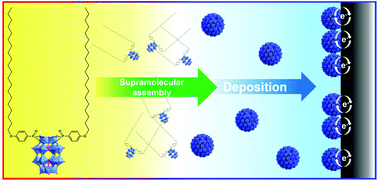Redox-active hierarchical assemblies of hybrid polyoxometalate nanostructures at carbon surfaces†
Abstract
The self-assembly of hierarchical nanostructures on surfaces is a promising strategy for the development of a wide range of new technologies, such as energy-storage devices and sensors. In this work we show that amphiphilic, organofunctionalized hybrid polyoxometalates spontaneously self-assemble on glassy carbon, graphene oxide, and highly oriented pyrolytic graphite to create hierarchical redox-active nanostructures. The electrochemical behaviour and stability of these supramolecular, nanostructured assemblies is explored in detail and their morphology is determined by comprehensive optical and spectroscopic analyses. The spontaneous assembly of these hybrid nanomaterials on both hydrophilic and hydrophobic carbons is compared and we discuss how this strategy may be a new, simple, and effective method of fabricating hierarchically modified electrode surfaces.



 Please wait while we load your content...
Please wait while we load your content...